
Anex-A-Gram box top
Back to index of Scrabble pages by Donald Sauter.
Please visit the Scrabble For Word Lovers introduction page.
For your internal navigation convenience:

Anex-A-Gram box top
Scrabble took its final shape in 1948. The first set of rules were copyright in December of that year. As you see on the box top, Anex-A-Gram has a 1938 copyright date. As far as I know, no one has found any reason to suspect that Scrabble didn't come out of Alfred Butts' head, and I don't mean to raise a suspicion here. I still think Alfred was the man.
But there are very interesting similarities between Anex-A-Gram and Scrabble. The rules for word placement on the board--forming a valid crossword puzzle--are the same. Only non-proper, dictionary-type words are allowed. The Anex-A-Gram board is 13x13 while the Scrabble board is 15x15. The letter distributions are quite similar (see further down.) There are two "wild cards" in each game.
On top of this is the coincidence of Alfred Butts putting down in a letter in 1938 that he was starting to work on the game that would eventually become Scrabble. (Word Freak, by Stefan Fatsis, page 96.)
The most fundamental difference between Anex-A-Gram and Scrabble is the Object. In Scrabble, you know it's to score the most points making use of the points assigned to the letters and the premium squares on the board. In Anex-A-Gram, no points are tallied for playing a word; the object is simply to be the first player to empty your rack, whereupon the other players are penalized for the tiles left in their racks.
Now that might sound like a big difference, but the two games really have a very similar feel. You know when you've found your play in Anex-A-Gram, just as you know when you've found your play in Scrabble even before totting up the score. In fact, many people may find this freedom from Scrabble's running stream of arithmetic a welcome relief. (I make the claim that probably not a Scrabble game in a hundred played in the home is scored completely correctly.)
Before we leave the box top, here's a little puzzle for you. Based on the box top graphic, what word familiar to everyone nowadays was missing from the 1936 Webster's Collegiate Dictionary? Now don't anyone give me a heart attack by actually reading my web page and responding to my brain teaser.
Also notice that the 1936 Webster's Collegiate included the two-letter plurals of the letters of the alphabet: AS, BS, CS . . . XS, YS, ZS. You'll also find them in almost any current dictionary you check. How it is that they've never made the official Scrabble dictionaries certainly ranks as one of the great mysteries of the universe.
Here are the Anex-A-Gram rules printed in the inner lid:

Or, you can examine the rules in plain text further down this page. I can't believe they really meant that, when you have an S and want to hook across the end of a word on the board, your S has to be the beginning letter of your word.
The Discard pile works like a discard pile in some rummy games, where the only card available for drawing from the pile is the one on top, that is, the most recent, previous discard.
Here are the racks and tiles:
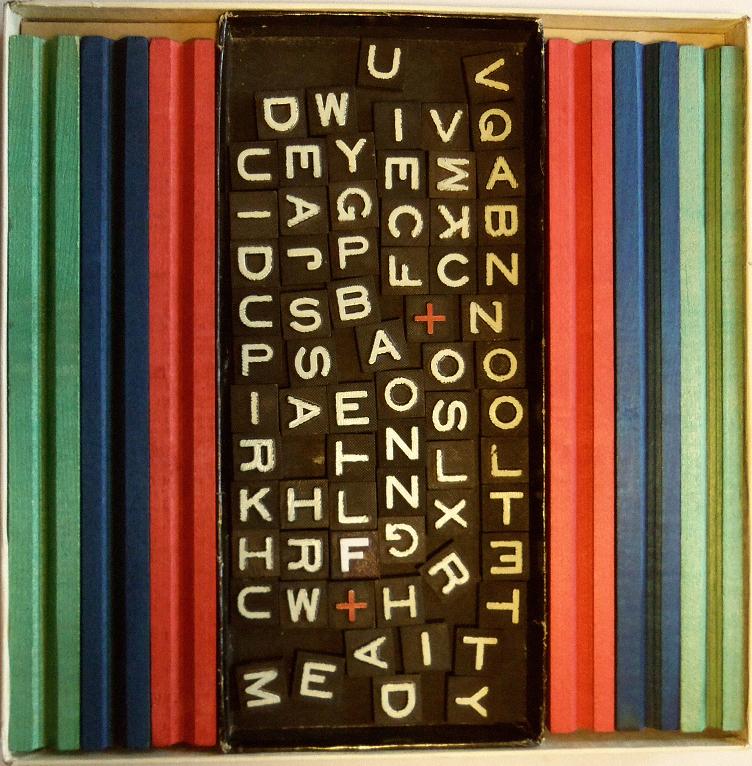
Looks sharp, eh? By the way, this set was originally owned by a Hollywood director named Bernard B. Ray who did a lot of B westerns. Ray's brother Leon Shamroy directed and produced some major films including Cleopatra and Planet of the Apes. When Ray's grandson put Anex-A-Gram up on eBay, I was the only bidder, which is all the evidence you need that civilization is in an unrecoverable nosedive.
The board is like a deluxe Scrabble board, but instead of a "raised grid", it has sunken holes which receive protruding disks on the back of the tiles. John Lennon played Scrabble on several occasions. If he played Anex-A-Gram, he could swing the board around with wild abdomen. (Very obscure joke for Beatle fans.)
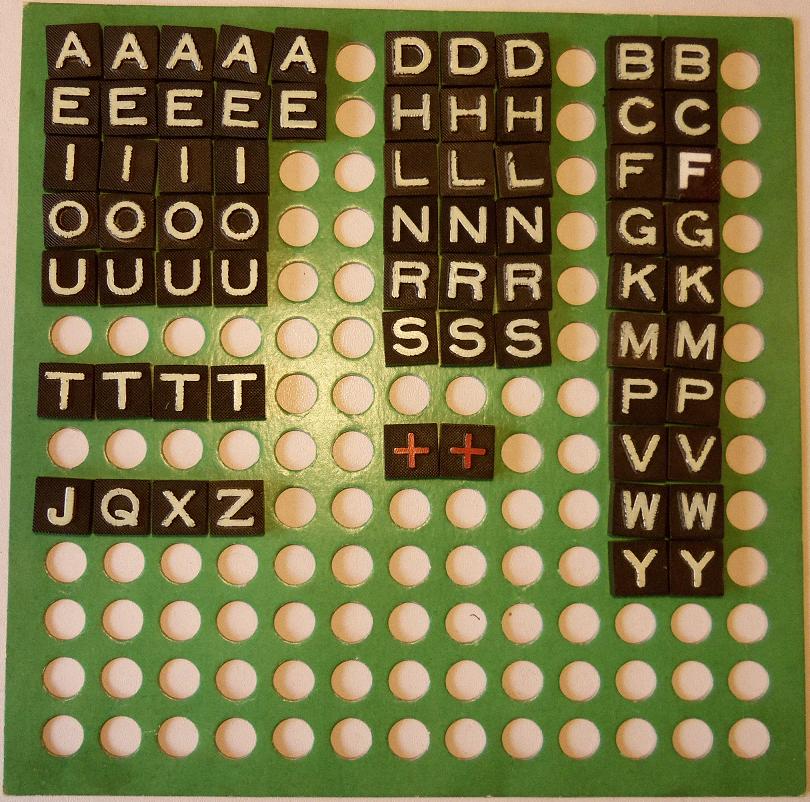
I had to make up a missing F. Ironically, I cut out a corner of a folded Scrabble board, which has just the right thickness, color, and texture.
The 22 "true vowels" (AEIOU) account for about 31% of the Anex-A-Gram tile set. The Scrabble tile set is 42% true vowels. I maintain the correct proportion should be about 39% to 40%, making Scrabble somewhat vowel heavy and Anex-A-Gram very consonant heavy. It really doesn't cause hardship, though, in games based on small words since there are tons of short words to get you out of any lopsided vowel-consonant jam.
Overall, though, the Anex-A-Gram letter distribution is very much in line with Scrabble's letter distribution. The extra K and the extra H throw them out of their familiar places in the lineup. Had Anex-A-Gram tripled the G (a "better" letter than H) and left the H a pair, the similarity would have been too eerie.
Now, take another look at the "Example of completed crossword" in the inner lid.
HOME
O VEIN
PANE ODE
HEN N TO
YES NINE
SUET
It could not have been formed with the provided tile set, since it has 8 E's and 6 N's. Did they mix in the "ACCESSORY SET full of extra letters" touted at the bottom of the lid? I doubt it; I think the rules writer just concocted the "completed crossword" out of her head.
Here's a very unlikely draw of Anex-A-Gram tiles. Then again,
every draw is very unlikely...

Here are the first couple of rounds of Anex-A-Gram played by me and my Dover Scrabble friends in February 2014. Might this be the first Anex-A-Gram played since the 1930s? In spite of my inclination to fix up game rules right from the outset, we followed the box top rules rigorously for this historic first session. Thus you will see a few plays consisting wholly of two-letter words (OF/IF, MU, AH/OH), which, as you may know, I haven't tolerated in Scrabble since the latter 1980s.
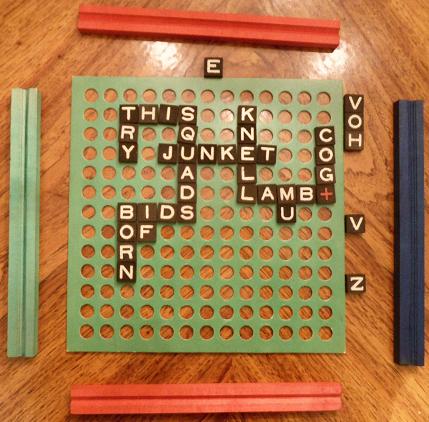

First Anex-A-Gram rounds in a lifetime!
The tiles off the top of the board are the Discard Piles, which, in these rounds, didn't get used. The tiles off to the right are what players were caught with when the other player went out. (Judy was stuck with a +, which is worth 5 points, oh my!)
To be honest, I found Anex-A-Gram somewhat unsatisfying. The main problem is not being rewarded for your individual plays, although perhaps that would not have been so bad before getting used to Scrabble. And it was just too darn easy to go out.
I don't let little things like that stop me, and it was upward and onward to Anex-A-Gram II! Here are the adjustments I made to make Anex-A-Gram a really great game:
And guess what?
It simply didn't come off. My Scrabble friends(?) would run off screaming at the sight of my Anex-A-Gram box.
For the first 3 years, this web page presented Anex-A-Gram II and the thinking behind it, and some sample games, in wonderful detail. Maybe it's somewhere on archive.org. But now I've yanked it.
What happened was, in November 2017 I finally found a copy of Crossword Anagrams. "What is Crossword Anagrams?", you ask.
Crossword Anagrams is the Embossing Company's own "Anex-A-Gram II", which they put out to compete with Scrabble in the mid-1950s.
They really didn't change anything of substance except for adding a simple scoring system for each play. And I think it works. At least it beats the "Anex-A-Scrabble" monster I developed above by a country mile. They turned Anex-A-Gram into a light, fun, and satisfying word game. Read all about it in my Crossword Anagrams page.
There was also a German game combining anagrams and crosswords from a couple of years earlier, in fact. It was called Typ-Dom and it has a 1936 patent. The pictures below should give you a fair idea of the game.
Typ-Dom box
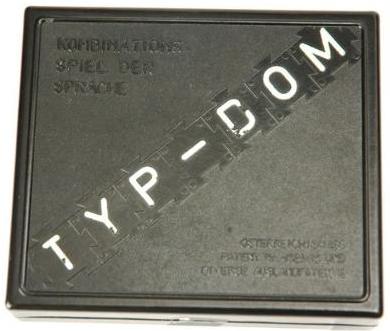
Typ-Dom intro

The title shows us that "Typ-Dom" comes from combining "type", as in printing blocks (German plural, Typen), and "domino". There are 50 black consonants (Mitlauten) and 30 red vowels (Selbstlauten). This yields a mix with about 37% vowels. (Remember that Anex-A-Gram has 31% vowels,and Scrabble has 42% vowels.)
Typ-Dom Spielsteinen (tiles)

Typ-Dom sample plays
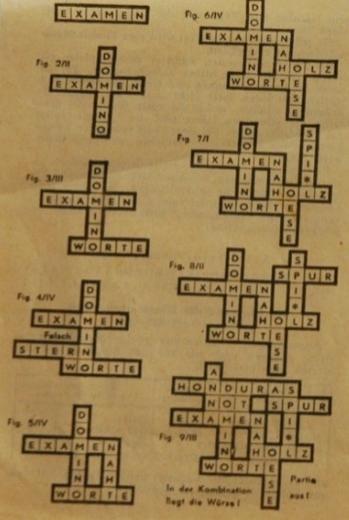
Notice the acceptance of proper nouns, such as HONDURAS, ANNA, und UTE. Also note Fig. 4 with its example of an illegal ("falsch", or false) play. STERN (star) forms the invalid word RW. And notice the wild card * tile in Fig. 7. It probably stands for E, forming SPIEL (play or game). Why do I have a suspicion there's another * in the tile set?
I think the pep talk says, "In der Kombination liegt die Würze!" ("The spice lies in the combinations!"), but, if you ask me, those final plays sure do look jerry-rigged - no pun or insult intended! (Well, maybe the pun.) I think the order had to be, HONDURAS, AN, and NOT, forming ANNA and UTE, since NO and OT aren't German words. As with the completed crossword example in Anex-A-Gram, this degree of interconnectivity in a Scrabble-like game is extremely unlikely. Yes, crossword puzzles are very dense, but the makers aren't picking the next letters to add at random!
So, Typ-Dom, Anex-A-Gram, and Scrabble -
what do you think? A bit of snitching? Or something in the air that
gave rise to completely independent brainstorms?
ANEX-A-GRAM
~~~~~~~~~~~~~~~~~~~~~~~~~~~~~~~~~~~~~~~ A GAME OF CROSSWORDS FOR 2 TO 6 PLAYERS ~~~~~~~~~~~~~~~~~~~~~~~~~~~~~~~~~~~~~~~
Before Starting:
Place the Anex-A-Gram Board in the center of the table, and the letters face down, thus forming the Draw Pile. Draw one apiece. Player whose letter is nearest "A" starts the game. Put these letters back and shuffle the pile. Each player now gets a rack, and draws accordingly:--
12 letters, if only 2 or 3 are playing.
10 letters for 4 or 5 players.
8 letters for 6 players.
Put your letters in your rack so no one else can see them.
Object of the Game:
Be the first to get rid of your tiles.
We're Off!
1. First player draws one tile (The Discard Letter) from the Draw Pile and places it, face up, on the opposite side of the board to start the Discard Pile. Now, studying his rack, he selects any 2, 3, or 4 of his letters (never more than 4) that spell a word and places that word on the board.
2. Next player to the left tries to make another word by adding from 1 to 4 letters to the first word. Suppose the second player has "C," "L" and "M," and the first word is "LAMP." He can get rid of his "C" this way:
CLAMP
Better yet, he can use all three (3) letters thus:
C
L
LAMP
M
3. If the third player has "A," "D" and "I," he could play:
Correctly Incorrectly
C C
L LAID
LAMP LAMP
MAID M
In the correct example, he has spelt in addition to the word "MAID," the words "MA" and "PI." In the incorrect example, in forming the horizontal word "LAID," he has made the vertical letters "I P" which do not form a word. As in crosswords, all words must read from top to bottom and from left to right. No unfinished word can ever be left on the board.
You're Stuck!
Whenever a player can't make a word with the letters in his own rack, he discards one tile, face up, along side of the Discard Letter. He then can draw either the Discard Letter, or turn it down and take a tile from the Draw Pile. In either case, he loses his turn until the play comes around again.
If the Draw Pile gets used up, give the Discard Pile a good shuffling and use it for drawing. Then turn up a letter to start your new Discard Pile.
Taboo:
Proper names, words not in a dictionary and plurals are not permissible. Exceptions:--
1. You can't add "S" or "ES" to any word on the board unless you're spelling a word that begins with "S" in the opposite direction.
LAMPS
H
O
E
(The word "shoe" was played last.)
2. If "S" is already on the board as in the "MAST," it's O.K. to form the word "CATS."
C
A
T
MAST
Plus Tiles!
You're in luck if you draw a tile with a plus sign (+) because at any point in the game it can be played as any letter. Once played, however, the Plus Tile is always considered the letter for which it was played.
The Winner:
The first to get rid of his letters wins the round. He scores 0. The others are charged for the letters still in their hands as follows:
1 point for each consonant
2 for each vowel (A, E, I, O, U)
5 for each Plus Tile
As soon as any player gets a score of 10 or more the game is over, and the player with lowest score wins the game.
Example of completed crossword:
HOME
O VEIN
PANE ODE
HEN N TO
YES NINE
SUET
Another Game by THE EMBOSSING COMPANY
ALBANY, NEW YORK, U. S. A.
P.S.--Your dealer's got an ACCESSORY SET full of extra letters--same price
as ANEX-A-GRAM.
Additional Boards--around 15¢ a throw!
Since I did sink a lot of effort into perfecting Anex-A-Gram, and you can't find these things just anywhere, here are a few boards created in the experimentation that led to Anex-A-Gram II.

First play INERTLY.

First play READILY.

First play OFF.
And that's UNDERSIZE, not -SIDE.
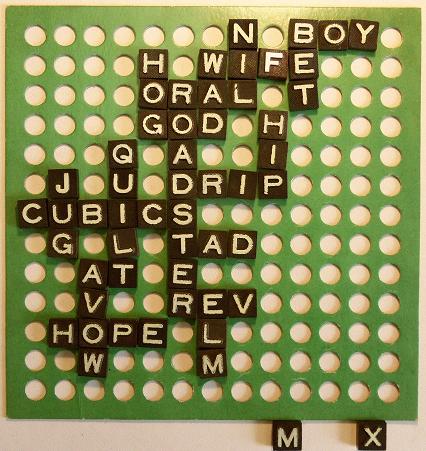
First play CUBIC.

First play VIZOR.

First play OUTSIDE.

First play EXEGESIS.
And the mystery word is... HAT!
And here are a few rounds from the first couple of real Anex-A-Gram II games, played, as you see, with a modified Scrabble set.




Contact Donald Sauter: send an email; view guestbook; sign guestbook.
Back to Donald Sauter's main page.
Back to the top of this page.
Helpful keywords not in the main test: zucchini; splashy; animalcula.